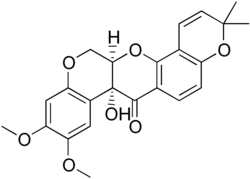Tephrosin
 | |
| Names | |
|---|---|
| IUPAC name
7a-Hydroxy-9,10-dimethoxy-3,3-dimethyl-13,13a-dihydro-3H,7aH-pyrano[2,3-c;6,5-f']dichromen-7-one
| |
| Other names
12aβ-hydroxydeguelin[1]
| |
| Identifiers | |
3D model (JSmol)
|
|
| ChEBI | |
| ChEMBL | |
| ChemSpider | |
| ECHA InfoCard | 100.231.407 |
| KEGG | |
PubChem CID
|
|
| UNII | |
CompTox Dashboard (EPA)
|
|
| |
| |
| Properties | |
| C23H22O7 | |
| Molar mass | 410.41658 g/mol |
| Related compounds | |
Related compounds
|
Deguelin, toxicarol |
Except where otherwise noted, data are given for materials in their standard state (at 25 °C [77 °F], 100 kPa).
Infobox references
| |
Tephrosin is rotenoid. It is a natural fish poison found in the leaves and seeds of Tephrosia purpurea[2] and T. vogelii.[3]
See also
References
- ^ Cabizza, Maddalena; Alberto Angioni; Marinella Melis; Marco Cabras; Carlo V. Tuberoso; Paolo Cabras (2004). "Rotenone and rotenoids in cubè resins, formulations, and residues on olives". Journal of Agricultural and Food Chemistry. 52 (2): 288–293. Bibcode:2004JAFC...52..288C. doi:10.1021/jf034987a. PMID 14733510.
- ^ Ahmad, V. U.; Z. Ali; S. R. Hussaini; F. Iqbal; M. Zahid; M. Abbas; N. Saba (1999-08-01). "Flavonoids of Tephrosia purpurea". Fitoterapia. 70 (4): 443–445. doi:10.1016/S0367-326X(99)00046-5.
- ^ Production of rotenoids by heterotrophic and photomixotrophic cell cultures of tephrosia vogelii. Nadine Lambert, Marie-France Trouslot, Claudine Nef-Campa and Hervé Chrestin, Phytochemistry, Volume 34, Issue 6, December 1993, Pages 1515-1520, doi:10.1016/S0031-9422(00)90838-0